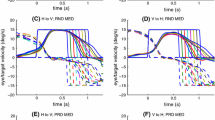Abstract
Smooth-pursuit eye movements were recorded in two rhesus monkeys in order to compare the influence of structured visual backgrounds on smooth-pursuit initiation, steady-state pursuit and pursuit termination. Different target trajectories were used in order to study smooth-pursuit initiation and termination. The influence of visual backgrounds on pursuit initiation was characterized by recording ocular responses elicited by stepramp target displacements starting from straight ahead. Pursuit termination was characterized by analysing the transition from steady-state smooth-pursuit to fixation when a centripetally directed target ramp was terminated by a small target step in the direction of the ramp as soon as the target had come close to the straightahead position. The quantification of steady-state pursuit was based on ocular responses elicited by either paradigm. In accordance with previous work, we found that the onset of smooth-pursuit eye movements was delayed and initial eye acceleration reduced in the presence of a structured visual background. Likewise, mean eye velocity during steady-state pursuit was reduced by structured visual backgrounds. However, neither the latency nor the time course of smooth-pursuit termination was altered when the homogeneous background was replaced by a structured visual background. The lack of sensitivity of pursuit termination to the presence of visual structured backgrounds supports a previous contention that pursuit termination is mediated by a process which is different from the ones mediating smooth-pursuit initiation and steady-state pursuit. The absence of any noticeable effect of structured backgrounds on pursuit termination suggests that at least the fast component of the optokinetic reflex is suppressed during pursuit termination.
Similar content being viewed by others
References
Bahill AT, McDonald JD (1983) Frequency limitations and optimal step size for the two-point central difference derivative algorithm with applications to human eye movement data. IEEE Trans Biomcd Electron BML 30:191–194
Cohen B, Matsuo V, Raphan T (1977) Quantitative analysis of the velocity characteristics of optokinetic nystagmus and optokinetie after-nystagmus. J Physiol (Lond) 270:321–344
Collewijn H (1969) Optokinetic eye movements in the rabbit: inputoutput relations. Vision Res 9:117–132
Collewijn H, Tamminga EP (1983) Human smooth and saccudic eye movements during voluntary pursuit of different target motions on different backgrounds. J Physiol (Lond) 351:217–250
Collewijn H, Van der Steen J, Steinman RM (1985) Human eye movements associated with blinks and prolonged eyelid closure. Vision Res 25:11–27
Fischer B, Boch R (1983) Saccadic eye movements after extremely short reaction times in the monkey. Brain Res 260:21–26
Goldreich D, Krauzlis RJ, Lisberger SG (1992) Effect of changing feedback delay on spontaneous oscillations in smooth pursuit eye movements of monkeys. J Neurophysiol 67:625–638
Hamming RW (1987) Digitale Filter. VCH Verlagsgesellschaft, Weinheim
Ilg UJ, Bremmer F, Hoffmann K-P (1993) Optokinetic and pursuit system: a case report. Behav Brain Res 57:21–29
Judge SJ, Richmond BJ, Chu FC (1980) Implantation of magnetic search coils for measurement of eye position: an improved method. Vision Res 20:535–538
Keller EL, Khan NS (1985) Smooth-pursuit initiation in the presence of a tcxtured background in monkey. Vision Res 26:943–955
Kimmig HG, Miles FA, Schwarz U (1992) Effects of stationary textured backgrounds on the initiation of pursuit eye movements in monkeys. J Neurophysiol 68:2147–2164
Krauzlis RJ, Lisberger SG (1989) A control systems model of smooth pursuit eye movements with realistic emergent properties. Neural Comput 1:116–122
Lisberger SG, Westbrook LE (1985) Properties of visual inputs that initiate horizontal smooth pursuit eye movements in monkeys. J Neurosci 5:1662–1673
Lisberger SG, Morris LJ, Tychsen E (1987) Visual motion processing and sensory-motor integration for smooth pursuit eye movements. Annu Rev Neurosci 10:97–129
Luebke AE, Robinson DA (1988) Transition dynamics between pursuit and fixation suggest different systems. Vision Res 28:941–946
Mohrmann H, Thier P (1992) Smooth-pursuit initiation and steady state smooth pursuit in the presence of a textured background: effects of background structure and training. Eur J Neurosci Suppl 5:278, no. 4221
Robinson DA (1965) The mechanics of human smooth pursuit eye movements. J Physiol 186:569–591
Robinson DA (1981) Control of eye movements. In: Brooks VB (eds) Handbook of physiology. Vol II, Part 2. The Nervous System. American Physical Soc. Bethesda, pp 1275–1320
Robinson DA, Gordon JL, Gordon SE (1986) A model of the smooth pursuit eye movement system. Biol Cybern 55:43–57
Thier P, Koehler W, Buettner UW (1988) Neuronal activity in the dorsolateral pontine nucleus of the alert monkey modulated by visual stimuli and eye movements. Exp Brain Res 70:496–512
Worfolk R, Barnes GR (1992) Interaction of active and passive slow eye movement systems. Vision Res 90:589–598
Wurtz RH (1969) Visual receptive fields of striate cortex neurons in awake monkeys. J Neurophysiol 32:727–742
Yee RD, Daniels SA, Jones OW, Baloh RW, Honrubia V (1983) Effects f an optokinetic background on pursuit eye movements. Invest Ophthalmol Vis Res 24:1115–1122
Young LR, Forster JD, Van Houtte N (1968) A revised stochastic sample model for eye tracking movements. 4th Ann NASA-Univ Conf Manual Control. University of Michigan, Ann Arbor
Author information
Authors and Affiliations
Rights and permissions
About this article
Cite this article
Mohrmann, H., Thier, P. The influence of structured visual backgrounds on smooth-pursuit initiation, steady-state pursuit and smooth-pursuit termination. Biol. Cybern. 73, 83–93 (1995). https://doi.org/10.1007/BF00199058
Received:
Accepted:
Issue Date:
DOI: https://doi.org/10.1007/BF00199058




